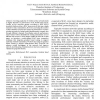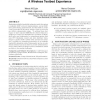AINA
2010
IEEE
14 years 5 months ago
2010
IEEE
— Growing popularity of wireless ad hoc networks leads to higher demands on performance of all TCP/IP stack layers. Usually ad hoc networks operate according to IEEE 802.11 stand...
WOWMOM
2005
ACM
14 years 5 months ago
2005
ACM
We present in this paper an analytical model that accounts for the positions of stations with respect to the Access Point (AP) while evaluating the performance of 802.11 MAC layer...
ICDCS
2005
IEEE
14 years 6 months ago
2005
IEEE
Power heterogeneous ad hoc networks are characterized by link layer asymmetry: the ability of lower power nodes to receive transmissions from higher power nodes but not vice versa...
BROADNETS
2005
IEEE
14 years 6 months ago
2005
IEEE
— Lightweight protocols that are both bandwidth and power thrifty are desirable for sensor networks. In addition, for many sensor network applications, timeliness of data deliver...
MOBICOM
2006
ACM
14 years 6 months ago
2006
ACM
Evaluating available bandwidth estimation methods requires a malleable MAC protocol implementation, precise MAC layer packet timing measurements, and the ability to create control...
VTC
2006
IEEE
14 years 6 months ago
2006
IEEE
— We focus in this paper on the cross-layer modeling of the integration of streaming and elastic flows in the downlink of UMTS/HSDPA systems. Streaming flows are transported ov...
INFOCOM
2007
IEEE
14 years 6 months ago
2007
IEEE
—The design of multi-channel multi-hop wireless mesh networks is centered around the way nodes synchronize when they need to communicate. However, existing designs are confined ...
ICC
2007
IEEE
14 years 6 months ago
2007
IEEE
— In sensor networks, MAC protocols based on Time Division Multiple Access (TDMA) with wakeup and sleep periods have attracted considerable interest because of their low power co...
GLOBECOM
2007
IEEE
14 years 6 months ago
2007
IEEE
—The Enhanced Distributed Channel Access (EDCA) function of IEEE 802.11e standard defines multiple Access Categories (AC) with AC-specific Contention Window (CW) sizes, Arbitra...
SEUS
2008
IEEE
14 years 6 months ago
2008
IEEE
In this study, we propose ARF-aware TCP that resolves the performance anomaly in 802.11 WLAN networks. Performance anomaly is a network symptom that fairness among the nodes is bro...




